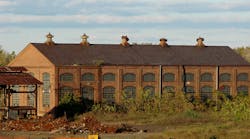How digital greenfield projects can pave the way for brownfield IoT success
Connectivity is king for the industrial internet of things (IIoT). Connectivity of machines, devices, data, and people is the hallmark of digital transformation and of all the opportunities that come with it. While the pace and extent of digitalization varies from plant to plant, the greatest divergence is between new (greenfield) and existing (brownfield) sites.
In a fully optimized plant, everything is smart: the machines, instrumentation and control systems, sensors, motor controls, robotic systems, condition monitoring devices, safety systems, and more. Full optimization may be achievable in greenfield projects with adequate capital funding, but legacy sites can only hope for piecemeal deployments.
Digitalized asset monitoring and management is becoming the norm in brand new plants, but it is also a launching point for IIoT in existing and limited-budget environments.
Boosting brownfield performance
At brownfield sites, IIoT initiatives are typically associated with upgrade or expansion projects. Digitalization is more challenging in these environments due to aging facilities, equipment, and networking systems (or lack thereof), as well as data that is often siloed or paper based and generally of inferior quality. It is, however, a necessary endeavor in order to benefit from IIoT-enabled operational improvements.
Many older plants are in dire need of asset optimization, making transitioning from run-to-failure (RTF) and routine preventive maintenance (PM) practices to condition monitoring and predictive maintenance (PdM) a prominent IIoT goal. Adequately identifying and correcting deteriorating machine conditions before failure requires open, standards-based communications along with integration and interoperability between various wired and wireless machine sensors, portable or drone-based condition monitoring devices, and enterprise asset and service management software.
Vibration analysis, thermography, ultrasound, and oil analysis are common PdM approaches. Real-time, threshold-driven alerts prompt the planning and scheduling of repairs or replacements, and automatic escalation ensures the work is completed in time to avoid costly equipment failure. As a result, PdM helps to reduce maintenance and inventory costs, improve safety and performance, and extend asset longevity.
The newer iteration of PdM is prescriptive maintenance (RxM), which not only predicts failure but also recommends or “prescribes” corrective actions with help from advanced analytics. Assets that would benefit most from failure prediction and prevention, whether for production, safety, or environmental reasons, are prime candidates for PdM and RxM investments in existing plants.
Advanced analytics leverage machine learning (ML), artificial intelligence (AI), and pattern recognition to formulate decisions from streaming and static big data, with minimal human intervention. Analytics in the cloud and on edge devices help to form better conclusions about asset management and maintenance, from predicting or diagnosing failures, to making repair and replacement decisions, to proactively applying the actions to similar assets under similar conditions. Over time, the algorithms become “smarter” and more accurate as the systems learn from experience.
3D modeling and simulation of assets, systems, processes, and complete plants is possible with digital replicas, or twins. Older plants tend to deploy digital twins on a smaller scale due to incompatible data sources, structures, and equipment, which complicate setup. The IIoT-enabled capability is useful for simulating operation, monitoring machine health, predicting maintenance, simulating repair scenarios, and forecasting responses to process changes. To remain effective, digital twins must be continuously updated to match changes made to the physical twin.
Augmented reality (AR), virtual reality (VR), mixed reality (MR), and virtual agents provide new and immersive ways to tackle personnel training, development, and collaboration. Field service and plant maintenance roles can be learned and practiced in safe, realistic environments, and conducted live with on-demand access to remote experts for advice or collaboration. The technology is helpful for retraining and reskilling personnel for new roles arising from digitalization.
Data quality and accessibility, qualities seldom associated with older plants, are fundamental to effective AI and ML. Since learning from bad data will inevitably produce faulty results, some companies are establishing data quality groups focused on cleansing data, making ML a more viable goal. Example objectives include ensuring data relevance, accuracy, completeness, and integrity; eliminating redundancies; and digitizing knowledge stored in the memories or personal records of seasoned professionals.
Resistance to change is another challenge unique to existing plants. New technologies and processes disrupt established comfort zones, creating fear of failure, fear of being replaced, and lack of buy-in. Employees who thrive on new technology adapt better, but those who don’t may find digital transformation a threat. Effective organizational change management is imperative to ensure IIoT and digitalization projects succeed.
Engineering greenfield sites for reliability
The advantage for new plants is the clean slate from which they are designed, modeled, and engineered for reliability. Industry 4.0 greenfield smart factories are digitalized from the ground up. They have an open IIoT architecture that is standards-based, interoperable, extensible, scalable, and adaptable to new and inevitably improving technologies. They enjoy full democratization of data and are staffed by employees who embrace all things digital.
Greenfield plants uniquely benefit from fresh, clean data; state-of-the-art assets, systems, and processes; integrated smart devices and sensors; and full connectivity. Some are so robotic and AI-driven that asset management and monitoring is performed off-site and maintenance crews are only dispatched on an as-needed basis.
In brand new plants, it is feasible to create a digital twin of the entire plant and all its equipment, from conception to the as-designed, as-built, and progressive as-maintained states. Modeling and simulation of assets and processes using clean, complete, quality data ensures the analytics are more intelligent, the PdM and RxM findings are timelier, the prescribed actions are more accurate, and the ML delivers increasing intelligence and value to the organization. Having a digital twin of the whole plant extends the value, enabling plant-wide continuous improvement.
Universal appeal of IIoT for asset management and monitoring
Digitalization of asset management and monitoring, implemented with the latest cybersecurity best practices, offers lucrative rewards. It sets the path for maintenance and field service optimization for plants of any age, and for maintenance and reliability service providers. It also accelerates the journey to a servitization business model for original equipment manufacturers (OEMs).
Greenfield and brownfield asset owners and operators, service providers, and OEMs all benefit from heightened awareness of machine operating and performance trends, ever-smarter analytics, early notification of anomalies, and efficient, cost-effective corrective actions. The resultant improvements in uptime, performance, and productivity are evidenced in key performance indicators such as mean time between failure (MTBF), mean time to repair (MTTR), and overall equipment effectiveness (OEE). If you are not already on the IIoT journey, now is the time to start.


